Forecasting Infrastructure Needs, Environmental Impacts, and Dynamic Pricing for Electric Vehicle Charging
Abstract
1. Introduction
- Policy Recommendations: Offering evidence-based advice to policymakers on infrastructure development and pricing strategies.
- Urban Planning: Assisting urban planners in designing efficient, accessible EV charging networks that support rapid adoption.
- Economic Viability: Proposing strategies for economically sustainable EV charging infrastructure, ensuring affordability for users while maintaining profitability.
- Environmental Impact: Highlighting the potential environmental benefits of widespread EV adoption and the optimisation of charging networks.
2. Related Works
2.1. History of EVs and Charging Infrastructure
2.2. CO2 Emissions and Environmental Impact
2.3. Pricing and Economic Impact of EV Market Expansion
2.4. Technological Advancements and Design Considerations
2.5. Shortcomings in EV Charging Pricing and Infrastructure
3. Methodology
3.1. Dataset Description
- Identification: Station names, media access control (MAC) addresses, and organizational info.
- Temporal Data: Session start/end times, durations, transaction dates.
- Energy Usage: Energy consumed in kWh.
- Environmental Impact: GHG savings (kg), gasoline savings (gallons).
- Station Details: Port/plug types, electric vehicle supply equipment (EVSE) ID, system serial number (S/N), model number.
- Geography: Full address, city, state, ZIP, latitude, longitude.
- Financial Info: Currency and fee details.
- Driver Info: User ID, postal code.
3.2. Data Preparation
3.3. Feature Engineering
- Charging Time (seconds): Duration in seconds during which the vehicle was actively drawing electricity. It reflects energy usage efficiency and informs environmental impact estimates.
- Total Duration (seconds): Total plugged-in time, from connection to disconnection, including idle time. Essential for modelling usage behaviour and station occupancy.
- Holiday: Indicates whether the session occurred on a U.S. federal holiday. This feature accounts for potential variations in demand due to public holidays. The federal holidays were identified according to the U.S. government’s official list [35].
- Weekday/Weekend, Day of Week: Classifies each session as occurring on a weekday or weekend and records the specific weekday name. Useful for capturing routine behaviour patterns.
- Price per kWh: Calculated by dividing the total session fee by the amount of energy consumed (in kilowatt-hours). This derived feature is essential for understanding the relationship between cost and user behaviour. It enables analysis of how drivers respond to varying prices, supporting the development of dynamic pricing strategies that adjust rates based on time, demand, or other conditions [36,37]. Such pricing models help operators optimise revenue, manage station congestion, and influence charging habits (e.g., encouraging off-peak usage).
- YearMonth: Combines year and month to capture seasonal or monthly trends and support long-term demand forecasting.
- GHG/Gasoline Savings Model: GHG Savings (kg), Gasoline Savings (gallons)
- Dynamic Pricing Model: Energy (kWh)
- Demand Forecasting Model: Energy (kWh)
3.4. Missing Values and Outliers
- GHG Model: Interquartile range (IQR)-based outlier removal was applied to GHG and gasoline savings values. This ensured that extreme or anomalous values did not distort the environmental impact analysis.
- Pricing Model: Data from before 1 August 2017 was excluded, as charging was free prior to this date. Outliers in price per kWh were also removed to maintain a realistic representation of market-based pricing behaviour.
- Forecasting Model: Outliers in energy consumption were eliminated to improve the accuracy of long-term demand predictions. This step was crucial for preserving the integrity of seasonality and trend modelling.
- Remaining NaNs: After cleaning and dropping irrelevant columns, any rows containing missing (NaN) values were removed. This ensured a complete dataset and reduced the risk of introducing bias or computational errors in the models.
3.5. Feature Scaling
3.6. Variation Analysis
- Energy Consumption Dips in 2018 and 2020:
3.7. Model Selection
- GHG and Gasoline Savings Model
- Dynamic Pricing Model
- y: Observed values.
- X: Predictor variables.
- w: Coefficient vector.
- : Regularisation parameter.
- : Squared Euclidean norm [42].
- Demand Forecasting Model
3.8. Hypothesis Testing
- Daily Variations in Charging Times
- : Mean charging duration for the specific day.
- : mean charging duration on all other days.
- Federal Holiday vs. Non-Federal Holiday Charging Times
- : Mean charging time on federal holidays.
- : Mean on non-federal holidays.
4. Results
4.1. GHG and Gasoline Savings Model
Conversion Rates
- GHG saved per kWh: kg;
- Gasoline saved per kWh: gallons.
4.2. Dynamic Pricing Model
4.2.1. Utilisation Patterns and Peak Times
- Reduce wait times;
- Distribute demand more evenly throughout the day;
- Potentially delay the need for additional infrastructure.
4.2.2. Day-Based Charging Behaviour
4.2.3. Implementation of Dynamic Pricing
- Local policies;
- Infrastructure costs;
- Usage trends.
- Current Price: 0.25 USD/kWh
- Reduction (20%):
- Price for Friday and Saturday:
- Peak Hours: [9:00 PM, 4:00 AM)
- Off-Peak Hours: [4:00 AM, 9:00 PM)
- Implementation Plan For A Graduated Penalty System
- Goal: To optimise the use of EV charging stations by discouraging prolonged usage during peak hours and ensuring efficient turnover for increased user satisfaction.
- Justification: Efficient use of charging stations reduces wait times, accommodates more users, and enhances overall service quality.
- Policy Design
- Duration Thresholds:
- -
- 10–20% over charging time: Minor penalty
- -
- 21–40% over charging time: Moderate penalty
- -
- More than 40% over charging time: Major penalty
- -
- Minor penalty: 5 USD
- -
- Moderate penalty: 10 USD
- -
- Major penalty: 20 USD
- Observed non-federal holiday mean: Approximately 210 h
- Observed federal holiday mean: Approximately 135 h
- Difference:
- Target Increase (50% of the difference minimum):
- Days with Typical Usage (Sunday-Thursday).
- Standard Rate: 0.25 USD/kWh.
- Justification: This rate is maintained due to consistent demand observed from Sunday to Thursday.
- Expected Impact: Ensures stability in revenue from regular users while maintaining high utilisation.
- Underutilised Days (Friday and Saturday).
- Discount: 20% off to encourage charging.
- New Price: 0.20 USD/kWh.
- Justification: The lower prices are aimed at increasing charger usage on days with traditionally lower demand.
- Expected Impact: A projected increase in charger use by 15% during these days, based on previous underutilisation patterns.
- Hour-Based Pricing.
- Peak Hours (9:00 PM to 4:00 AM):
- –
- 15% price increase to manage congestion.
- –
- New Price: 0.2875 USD/kWh (Sunday–Thursday), 0.23 USD/kWh (Friday and Saturday).
- Justification: Higher prices during peak hours are designed to stagger charging times, reducing peak load.
- Expected Impact: Reduction in peak hour congestion by 25%, encouraging off-peak usage.
- Off-Peak Hours (4:00 AM to 9:00 PM):
- –
- Standard rate of 0.25 USD/kWh (Sunday–Thursday), 0.20 USD/kWh (Friday and Saturday).
- Justification: These rates aim to maintain a steady flow of users outside of peak times.
- Expected Impact: Consistent utilisation during off-peak hours without discouraging users due to high costs.
- Federal Holiday Pricing.
- Discount: Additional 20% off the total price to encourage federal holiday charging.
- Justification: The federal holiday discount is aimed at increasing usage during typically low-usage days, leveraging reduced rates to attract users.
- Expected Impact: An increase in charger usage by 27.8% on federal holidays compared to current numbers.
4.3. Demand Forecasting Model
- These stations started and ceased operations within 2020, possibly due to the COVID-19 pandemic.
- They continued operating beyond 2020, but this cannot be confirmed from the available data.
- Stations operating exclusively in 2020:
- 1.
- PALO ALTO CA/BRYANT #1
- 2.
- PALO ALTO CA/SHERMAN 1
- 3.
- PALO ALTO CA/SHERMAN 11
- 4.
- PALO ALTO CA/SHERMAN 14
- 5.
- PALO ALTO CA/SHERMAN 15
- 6.
- PALO ALTO CA/SHERMAN 17
- 7.
- PALO ALTO CA/SHERMAN 2
- 8.
- PALO ALTO CA/SHERMAN 3
- 9.
- PALO ALTO CA/SHERMAN 4
- 10.
- PALO ALTO CA/SHERMAN 5
- 11.
- PALO ALTO CA/SHERMAN 6
- 12.
- PALO ALTO CA/SHERMAN 7
- 13.
- PALO ALTO CA/SHERMAN 8
- 14.
- PALO ALTO CA/SHERMAN
- (1)
- Measurement Variability: Small variations in coordinates could be due to GPS accuracy or the way coordinates are recorded. This can result in slightly different coordinates for the same physical location.
- (2)
- Location Precision: The coordinates might be reported with different levels of precision, or the station might have multiple charging points or sensors that report slightly different coordinates.
- -
- Needs: Stations in this category exhibit a sustained upward trajectory in utilisation, approaching or exceeding practical capacity limits. They are projected to experience a significant increase in energy demand over the next five years, indicating an urgent need for infrastructure expansion or enhancement.
- -
- Might Need: These stations display moderate growth trends or intermittent peaks in demand. While not immediately critical, they may require upgrades or additional resources in the near future, particularly if fluctuations in peak demand become more frequent or pronounced.
- -
- Does Not Need: Stations in this group demonstrate flat or declining demand, with utilisation expected to remain within current capacity. As such, they do not warrant additional infrastructure investment in the short to medium term.
- Ultra-Fast Charging Networks: The development of ultra-fast charging networks can revolutionise EV charging by significantly reducing charging times to just a few minutes. This advancement will enhance convenience for EV owners, making the charging process comparable to traditional refueling times. As a result, range anxiety will be mitigated, encouraging more people to adopt EVs. Additionally, ultra-fast charging will make EVs more practical for daily use and accessible to those who lack home charging infrastructure [46].
- Wireless Charging Technology: Wireless charging technology allows EVs to charge through an electromagnetic field without the need for physical cables. This method improves convenience by eliminating the need to connect to a charging point and can reduce installation costs associated with traditional infrastructure. Wireless charging enables continuous charging while the vehicle is in use as charging starts automatically as soon as the vehicle enters an area with a wireless charging pad, thus improving efficiency and reducing wait times at charging stations [46].
- V2G Technology: V2G technology allows EVs to both draw power from and supply it back to the grid. This bi-directional flow enhances grid stability and helps integrate renewable energy by balancing supply fluctuations. It can offer financial incentives to EV owners through revenue from excess power and provides utilities with a flexible grid resource, potentially reducing the need for costly infrastructure upgrades [46].
- Providing More Charging Stations: Expanding the network of charging stations involves evaluating potential sites based on available land, accessibility, and regulatory approvals. This expansion can focus on adding stations in high-demand areas or nearby regions. It is essential to consider land availability, obtain necessary approval from landowners and government authorities, and ensure that the new locations are accessible for timely deployment and use.
5. Conclusions
5.1. Environmental Impact Assessment
5.2. Dynamic Pricing Strategies
- Days With Typical Usage (Sunday–Thursday): Standard rate of 0.25 USD/kWh.
- Underutilised Days (Friday and Saturday): Offers a 20% discount, setting the new rate at 0.20 USD/kWh.
- Hour-Based Pricing:
- –
- Peak Hours (9:00 PM to 4:00 AM): Price increases by 15%, making the price 0.2875 USD/kWh (Sunday–Thursday) and 0.23 USD/kWh (Friday and Saturday).
- –
- Off-Peak Hours (4:00 AM to 9:00 PM): Maintains standard rates of 0.25 USD/kWh (Sunday–Thursday) and 0.20 USD/kWh (Friday and Saturday).
The effectiveness of any hour-based tariff ultimately depends on real-world charging behaviour; rigorous discrete-choice or other behavioural economics studies are still required to confirm that users will actually shift demand in response to these price signals. - Federal Holiday Pricing: An additional 20% discount on overall price.
5.3. Implications for Policy and Urban Planning
5.4. Recommendations for Future Research
- (1)
- Dynamic Pricing Based On Location:Implement dynamic pricing strategies based on the location and congestion levels of each charging station. By adjusting prices according to how crowded each station is, we can effectively redirect traffic from busier locations to less-utilised areas. This strategy will not only improve service quality for users but also optimise station usage across different locations.
- (2)
- Hourly Dynamic Pricing and Mobile Tracking:Create an hourly dynamic pricing model for EV charging stations which adjusts rates based on real-time demand. This pricing strategy could be accompanied with a user-friendly mobile application that allows users to view current charging costs at different stations. This approach encourages users to charge their vehicles during off-peak hours and at stations with less demand, enhancing stations’ efficiency and user convenience while promoting cost savings and reducing congestion at highly frequented locations.
- (3)
- Integration of Renewable Energy Sources:Future studies should explore the practical implications and logistical challenges of integrating solar and wind energy into EV charging networks. This includes focusing on storage solutions for the intermittent nature of renewable sources and the economic impacts of such integrations. Research could also evaluate grid resilience with increased renewable integrations, modelling scenarios where large-scale renewable adoption influences energy prices and charging station profitability [26].
- (4)
- Advanced Battery Technology Impact:Investigate the impact of advancements in battery technologies, such as solid-state or lithium–sulfur batteries, on the dynamics of EV charging demand. Studies should quantify reductions in charging times and analyse the life cycle impacts of new battery technologies, including resource extraction, manufacturing emissions, recycling capabilities, and overall environmental footprints.
- (5)
- Smart Charging Systems and Grid Interactions:Develop models to optimise smart charging systems that can dynamically adjust to changes in electricity supply and demand, user behaviour, and pricing fluctuations. Explore the potential of V2G technologies and other bidirectional energy trade to provide grid services and evaluate the economic incentives necessary to encourage bidirectional energy exchange among EV owners [49,50,51].
- (6)
- User Behaviour Longitudinal Studies:Conduct long-term studies to observe how EV owners adapt their charging habits in response to changes in charging infrastructure, pricing models, and technology. Examine the effectiveness of different informational campaigns and incentives in modifying consumer behaviour towards more efficient and grid-supportive charging practices.
- (7)
- Economic Impact Comprehensive Analysis:Perform analysis on the economic impact of widespread EV adoption, including job creation, industry shifts, and consumer spending, with a focus on the macroeconomic effects of transitioning to electric transport.
- (8)
- Cross-City and Cross-Regional Comparative Studies:Expand research to include comparative analyses between different cities or regions with varying degrees of EV adoption and infrastructure development. Investigate the role of local policies, economic incentives, and urban planning in accelerating the transition to electric mobility.
- (9)
- Incorporation of Regionally Adjusted Emission Factors:This study used fixed conversion rates (0.42 kg CO2/kWh and 0.125 gallons/kWh) to estimate GHG and petrol savings, but this approach overlooks regional differences in grid carbon intensity and changes in energy generation. For example, electricity from coal-heavy grids emits more CO2 than that from renewable sources. Grid decarbonisation, policy shifts, and seasonal variations can all affect EV charging emissions. Future research should use dynamic, region-specific emission factors, possibly from real-time grid data (e.g., via energy regulator APIs). Sensitivity analyses across various energy mixes could also yield more accurate impact assessments. While beyond this study’s scope, these factors warrant further investigation.
- (10)
- Behavioural Modelling for Dynamic Pricing Response:Future studies should integrate behavioural economics and discrete choice theory to simulate and validate EV user responses to dynamic pricing. Models such as multinomial or nested logit can estimate how factors like pricing, convenience, and time-of-day affect user decisions. This behavioural modelling can then inform more accurate pricing strategies that account for variability in user preferences and socioeconomic backgrounds.
- (11)
- Integration of Operational Benchmarks into Demand Modelling:Charging station heterogeneity and operational constraints, such as throughput capacity, plug-in duration, and queue length, can be incorporated into demand forecasting and station categorisation. Using these parameters as benchmarks may improve the accuracy of infrastructure sufficiency assessments and provide actionable guidance for expansion planning. Future iterations could enhance the credibility and reproducibility of this classification by calibrating visual assessments against formal operational benchmarks, such as thresholds for connector occupancy, average plug-in durations, or the frequency of queuing. This would help translate trend-based observations into reproducible and quantifiable metrics.
- (12)
- Controlling for Multiple Comparisons in Hypothesis Testing:To improve the reliability of statistical inferences, future analyses should apply multiple testing correction methods such as Bonferroni or Holm adjustments when conducting hypothesis tests across several categories. This would help control the increased risk of Type I errors resulting from multiple comparisons.
- (13)
- Enhancing Accuracy in Environmental Projections:Incorporating dynamic emissions factors or conducting sensitivity analysis can improve the accuracy of environmental projections.
Supplementary Materials
Author Contributions
Funding
Data Availability Statement
Conflicts of Interest
References
- Louati, A.; Louati, H.; Kariri, E.; Neifar, W.; Farahat, M.A.; El-Hoseny, H.M.; Hassan, M.K.; Khairi, M.H. Sustainable Urban Mobility for Road Information Discovery-Based Cloud Collaboration and Gaussian Processes. Sustainability 2024, 16, 1688. [Google Scholar] [CrossRef]
- Punzo, G.; Panarello, D.; Castellano, R. Sustainable urban mobility: Evidence from three developed European countries. Qual. Quant. 2022, 56, 3135–3157. [Google Scholar] [CrossRef]
- Tran, M.; Banister, D.; Bishop, J.D.; McCulloch, M.D. Realizing the electric-vehicle revolution. Nat. Clim. Change 2012, 2, 328–333. [Google Scholar] [CrossRef]
- Noel, L.; Zarazua de Rubens, G.; Sovacool, B.K.; Kester, J. Fear and loathing of electric vehicles: The reactionary rhetoric of range anxiety. Energy Res. Soc. Sci. 2019, 48, 96–107. [Google Scholar] [CrossRef]
- Ayaz, F.; Nekovee, M. Towards Net-Zero Goal through Altruistic Prosumer based Energy Trading among Connected Electric Vehicles. In Proceedings of the 2023 IEEE Vehicular Networking Conference (VNC), Istanbul, Turkiye, 26 April 2023; pp. 89–96. [Google Scholar] [CrossRef]
- Neaimeh, M.; Salisbury, S.D.; Hill, G.A.; Blythe, P.T.; Scoffield, D.R.; Francfort, J.E. Analysing the usage and evidencing the importance of fast chargers for the adoption of battery electric vehicles. Energy Policy 2017, 108, 474–486. [Google Scholar] [CrossRef]
- Szabo, L.; Vascan, I. A Brief History of Electric Vehicles; Technical University of Cluj-Napoca: Cluj-Napoca, Romania, 2022; Available online: https://www.researchgate.net/publication/363520342_A_Brief_History_of_Electric_Vehicles (accessed on 13 June 2025).
- Arquivo.pt. Today in Technology History—6 July 2009. Available online: https://arquivo.pt/wayback/20091015184824/http:/www.tecsoc.org/pubs/history/2001/jul6.htm (accessed on 13 June 2025).
- Vepachedu Sreenivasarao. The History of the Electric Car. 2017. Available online: https://www.researchgate.net/publication/319787053_THE_HISTORY_OF_THE_ELECTRIC_CAR (accessed on 13 June 2025).
- Electric Car Charger Australia. The Short History of Electric Car Chargers. n.d. Available online: https://electriccarcharger.au/short-history-of-electric-car-chargers/ (accessed on 13 June 2025).
- Vilchez, J.J.; Jochem, P.; Fichtner, W. EV Market Development Pathways – An Application of System Dynamics for Policy Simulation. World Electr. Veh. J. 2013, 6, 1030–1038. [Google Scholar] [CrossRef]
- Creutzig, F.; Jochem, P.; Edelenbosch, O.Y.; Mattauch, L.; Van Vuuren, D.P.; Mccollum, D.; Minx, J. Transport: A roadblock to climate change mitigation? Science 2015, 350, 911–912. [Google Scholar] [CrossRef] [PubMed]
- City of Palo Alto. Electric Vehicles—City of Palo Alto, CA. n.d. Available online: https://www.cityofpaloalto.org/City-Hall/Sustainability/Electric-Vehicles (accessed on 13 June 2025).
- Liu, Z.; Wen, F.; Ledwich, G. Optimal planning of electric-vehicle charging stations in distribution systems. IEEE Trans. Power Deliv. 2013, 28, 102–110. [Google Scholar] [CrossRef]
- Zhao, Z.; Lee, C.K. Dynamic Pricing for EV Charging Stations: A Deep Reinforcement Learning Approach. IEEE Trans. Transp. Electrif. 2022, 8, 2456–2468. [Google Scholar] [CrossRef]
- Faisal, S.; Soni, B.P.; Goyal, G.R.; Bakhsh, F.I.; Husain, D.; Ahmad, A. Reducing the Ecological Footprint and charging cost of electric vehicle charging station using renewable energy based power system. e-Prime Adv. Electr. Eng. Electron. Energy 2024, 7, 100398. [Google Scholar] [CrossRef]
- Jin, L.; Slowik, P. Literature Review of Electric Vehicle Consumer Awareness and Outreach Activities. 2017. Available online: https://theicct.org/wp-content/uploads/2021/06/Consumer-EV-Awareness_ICCT_Working-Paper_23032017_vF.pdf (accessed on 13 June 2025).
- Limmer, S. Dynamic Pricing for Electric Vehicle Charging—A Literature Review. Energies 2019, 12, 3574. [Google Scholar] [CrossRef]
- Narasipuram, R.P.; Mopidevi, S. A technological overview & design considerations for developing electric vehicle charging stations. J. Energy Storage 2021, 43, 103225. [Google Scholar] [CrossRef]
- EZ EV Electric. The History of EV Charging Infrastructure. n.d. Available online: https://www.ezevelectric.com/the-history-of-ev-charging-infrastructure/ (accessed on 13 June 2025).
- Helmers, E.; Marx, P. Electric Cars: Technical Characteristics and Environmental Impacts. Environ. Sci. Eur. 2012, 24, 14. [Google Scholar] [CrossRef]
- Congressional Budget Office. Emissions of Carbon Dioxide in the Transportation Sector: At a Glance. 2022. Available online: https://www.cbo.gov/publication/58566 (accessed on 13 June 2025).
- International Council on Clean Transportation. U.S. Electric Vehicle Sales Soar into 2024. 2024. Available online: https://theicct.org/us-ev-sales-soar-into-24-jan24/ (accessed on 13 June 2025).
- Andrenacci, N.; Valentini, M.P. A Literature Review on the Charging Behaviour of Private Electric Vehicles. Appl. Sci. 2023, 13, 12877. [Google Scholar] [CrossRef]
- Yap, K.Y.; Chin, H.H.; Klemeš, J.J. Solar Energy-Powered Battery Electric Vehicle charging stations: Current development and future prospect review. Renew. Sustain. Energy Rev. 2022, 169, 112862. [Google Scholar] [CrossRef]
- Ayaz, F.; Nekovee, M. Smart Energy Management with Optimized Prosumerism for Achieving Dynamic Net-Zero Balance in Electrified Road Transport Networks. arXiv 2023, arXiv:2312.08162. [Google Scholar] [CrossRef]
- Morabito, D.; Imtiaz, M.H. Wireless Charging of Electric Vehicles: A Review. 2023. Available online: https://www.researchgate.net/publication/375924486_Wireless_Charging_of_Electric_Vehicles_a_Review (accessed on 13 June 2025).
- Cedillo, M.H.; Sun, H.; Jiang, J.; Cao, Y. Dynamic pricing and control for EV charging stations with solar generation. Appl. Energy 2022, 326, 119920. [Google Scholar] [CrossRef]
- Kaggle Contributor: Venkatsairo4899. EV Charging Station Usage of California City. 2024. Available online: https://www.kaggle.com/datasets/venkatsairo4899/ev-charging-station-usage-of-california-city?resource=download (accessed on 25 February 2025).
- The Pandas Development Team. Pandas: Python Data Analysis Library. 2024. Available online: https://pandas.pydata.org (accessed on 25 February 2025).
- Scikit-learn Developers. Scikit-learn: Machine Learning in Python. 2024. Available online: https://scikit-learn.org/stable/ (accessed on 25 February 2025).
- Matplotlib Development Team. Matplotlib: Visualization with Python. 2024. Available online: https://matplotlib.org (accessed on 25 February 2025).
- NumPy Developers. NumPy: The Fundamental Package for Scientific Computing with Python. 2024. Available online: https://numpy.org (accessed on 25 February 2025).
- The Mercury News. Palo Alto to Charge Fee for Electric Vehicle Charging. 2017. Available online: https://www.mercurynews.com/2017/07/26/palo-alto-to-charge-for-a-charge-at-ev-stations/ (accessed on 13 June 2025).
- U.S. Government. Federal Holidays in the United States. 2024. Available online: https://www.usa.gov/holidays (accessed on 13 June 2025).
- Moghaddam, Z.; Ahmad, I.; Habibi, D.; Masoum, M.A. A coordinated dynamic pricing model for electric vehicle charging stations. IEEE Trans. Transp. Electrif. 2019, 5, 226–238. [Google Scholar] [CrossRef]
- Borenstein, S.; Jaske, M.; Rosenfeld, A.; Org, E. UC Berkeley Recent Work Title Dynamic Pricing, Advanced Metering, and Demand Response in Electricity Markets. 2002. Available online: https://escholarship.org/uc/item/11w8d6m4 (accessed on 13 June 2025).
- Scikit-Learn Developers. StandardScaler—Scikit-Learn 1.5.1 Documentation. 2024. Available online: https://scikit-learn.org/stable/modules/generated/sklearn.preprocessing.StandardScaler.html (accessed on 13 June 2025).
- Onyeaka, H.; Anumudu, C.K.; Al-Sharify, Z.T.; Egele-Godswill, E.; Mbaegbu, P. COVID-19 pandemic: A review of the global lockdown and its far-reaching effects. Sci. Prog. 2021, 104, 368504211019854. [Google Scholar] [CrossRef] [PubMed]
- IBM. What Is Linear Regression? 2021. Available online: https://www.ibm.com/topics/linear-regression (accessed on 13 June 2025).
- Shiksha Online. Ridge Regression vs. Lasso Regression. 2021. Available online: https://www.shiksha.com/online-courses/articles/ridge-regression-vs-lasso-regression/ (accessed on 13 June 2025).
- Scikit-Learn Developers. Ridge—Scikit-Learn 1.5.1 Documentation. 2024. Available online: https://scikit-learn.org/stable/modules/generated/sklearn.linear_model.Ridge.html (accessed on 13 June 2025).
- DataScientest. SARIMAX Model: What Is It? How Can It Be Applied to Time Series? 2024. Available online: https://datascientest.com/en/sarimax-model-what-is-it-how-can-it-be-applied-to-time-series (accessed on 13 June 2025).
- EV Database. Useable Battery Capacity of Full Electric Vehicles Cheatsheet. n.d. Available online: https://ev-database.org/cheatsheet/useable-battery-capacity-electric-car (accessed on 13 June 2025).
- GeoPandas Developers. GeoPandas 1.0.1 Documentation. 2013. Available online: https://geopandas.org/en/stable/ (accessed on 13 June 2025).
- Priyadarshan, P. View of Electric Vehicle Charging Infrastructure: Current Status, Challenges, and Future Developments. 2019. Available online: https://research.tensorgate.org/index.php/IJIAC/article/view/25/23 (accessed on 13 June 2025).
- U.S. Environmental Protection Agency. Greenhouse Gas Emissions from a Typical Passenger Vehicle. 2023. Available online: https://www.epa.gov/greenvehicles/greenhouse-gas-emissions-typical-passenger-vehicle (accessed on 5 May 2025).
- U.S. Environmental Protection Agency. EPA Report: U.S. Cars Achieve Record High Fuel Economy and Low Emission Levels as Companies Fully Comply with Standards. 2023. Available online: https://www.epa.gov/newsreleases/epa-report-us-cars-achieve-record-high-fuel-economy-and-low-emission-levels-companies (accessed on 5 May 2025).
- Ayaz, F.; Nekovee, M. Quantum Optimization for Bidirectional Telecom Energy Exchange and Vehicular Edge Computing in Green 6G Networks. In Proceedings of the 2024 IEEE International Conference on Communications, Control, and Computing Technologies for Smart Grids (SmartGridComm), Oslo, Norway, 17–20 September 2024; pp. 385–390. [Google Scholar] [CrossRef]
- Ayaz, F.; Nekovee, M.; Saeed, N. Blockchain-based Energy Trading among UAVs and Base Stations for Net-Zero. In Proceedings of the 2024 IEEE 10th World Forum on Internet of Things (WF-IoT), Ottawa, ON, Canada, 10–13 November 2024; pp. 1–6. [Google Scholar] [CrossRef]
- Ayaz, F.; Nekovee, M.; Ibraheem, A.F. Telecom-to-Grid: Supercharging 6G’s Contribution for Reliable Net-Zero. IEEE Reliab. Mag. 2025, 2, 40–48. [Google Scholar] [CrossRef]
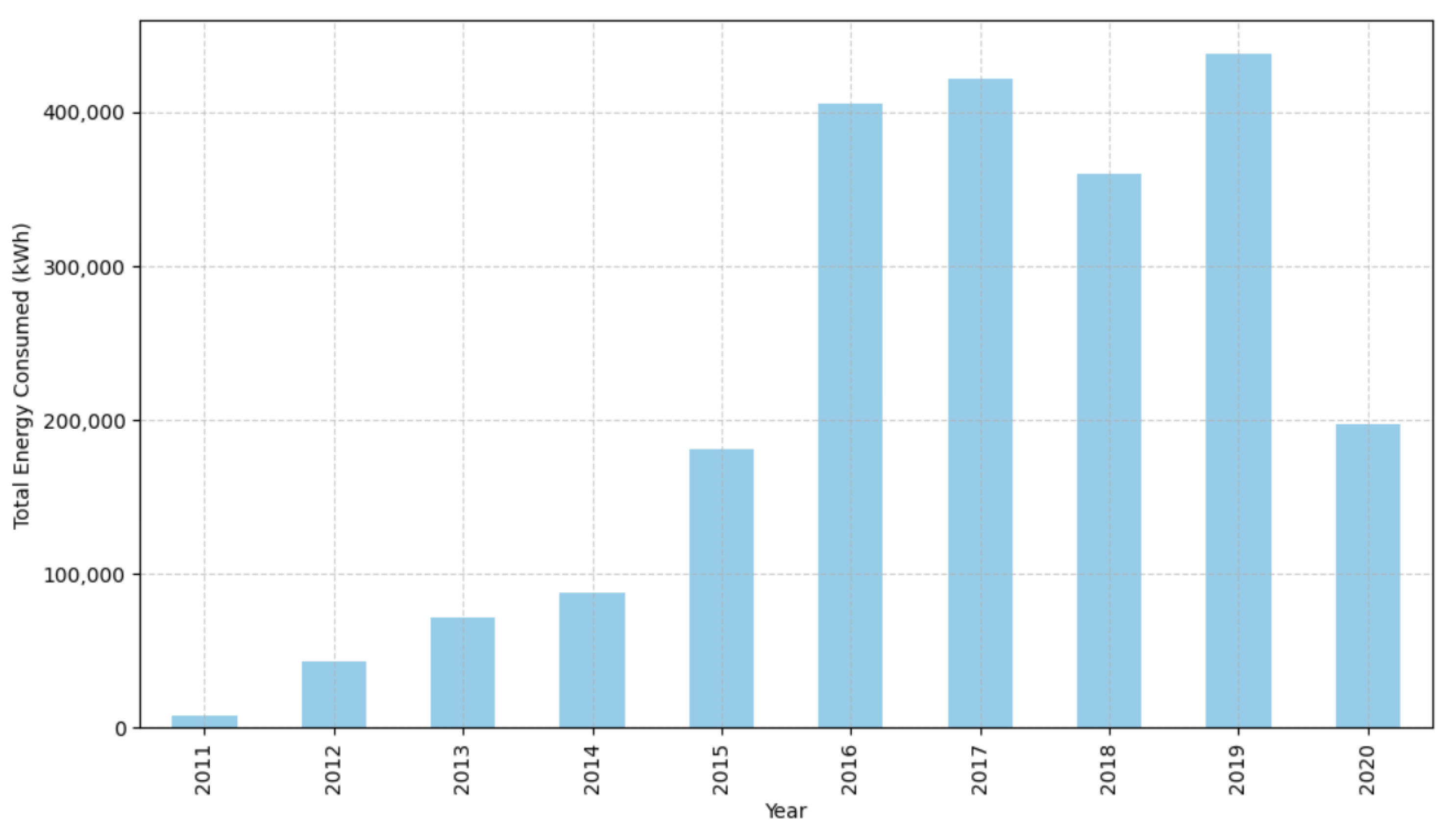
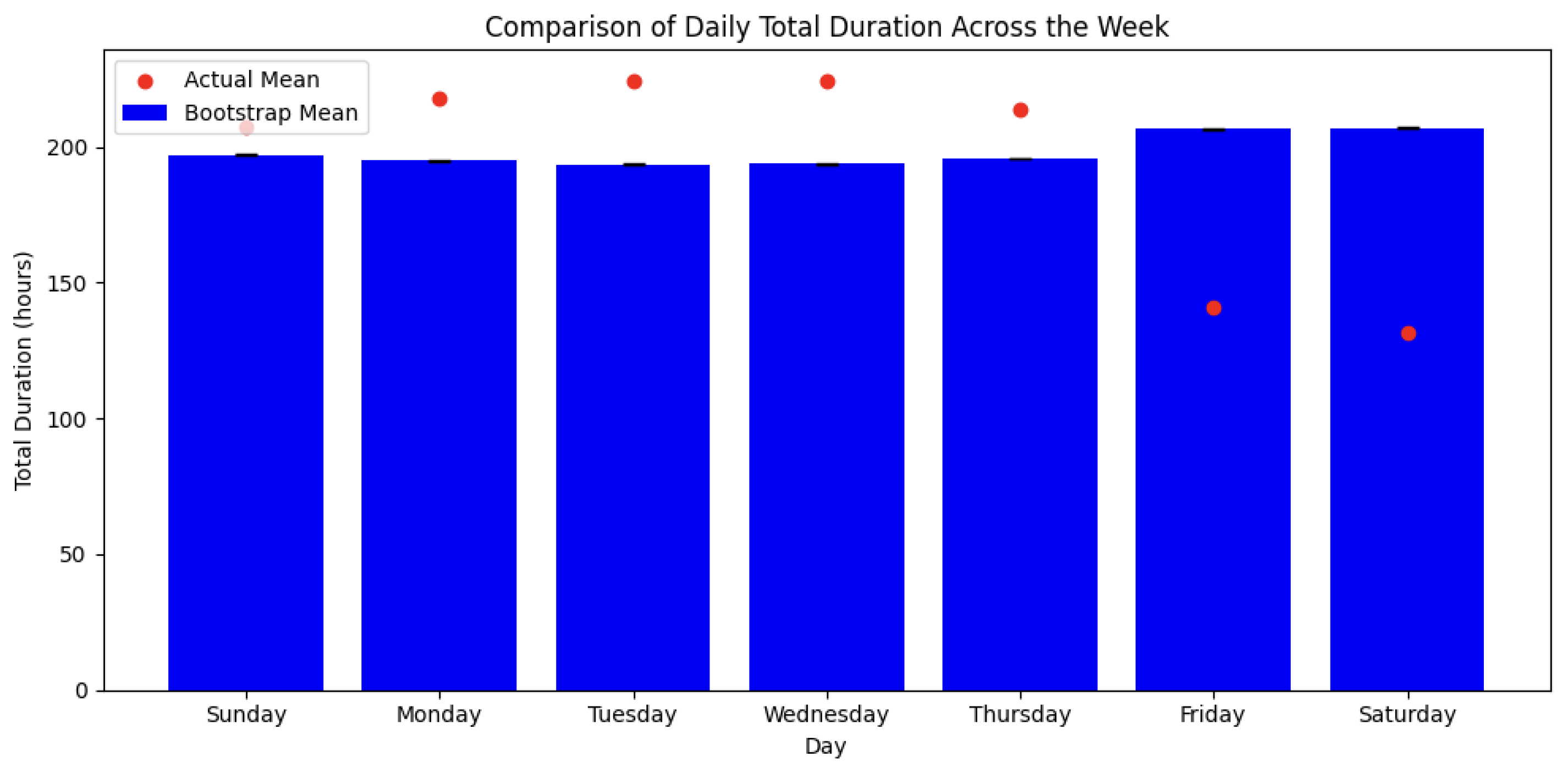
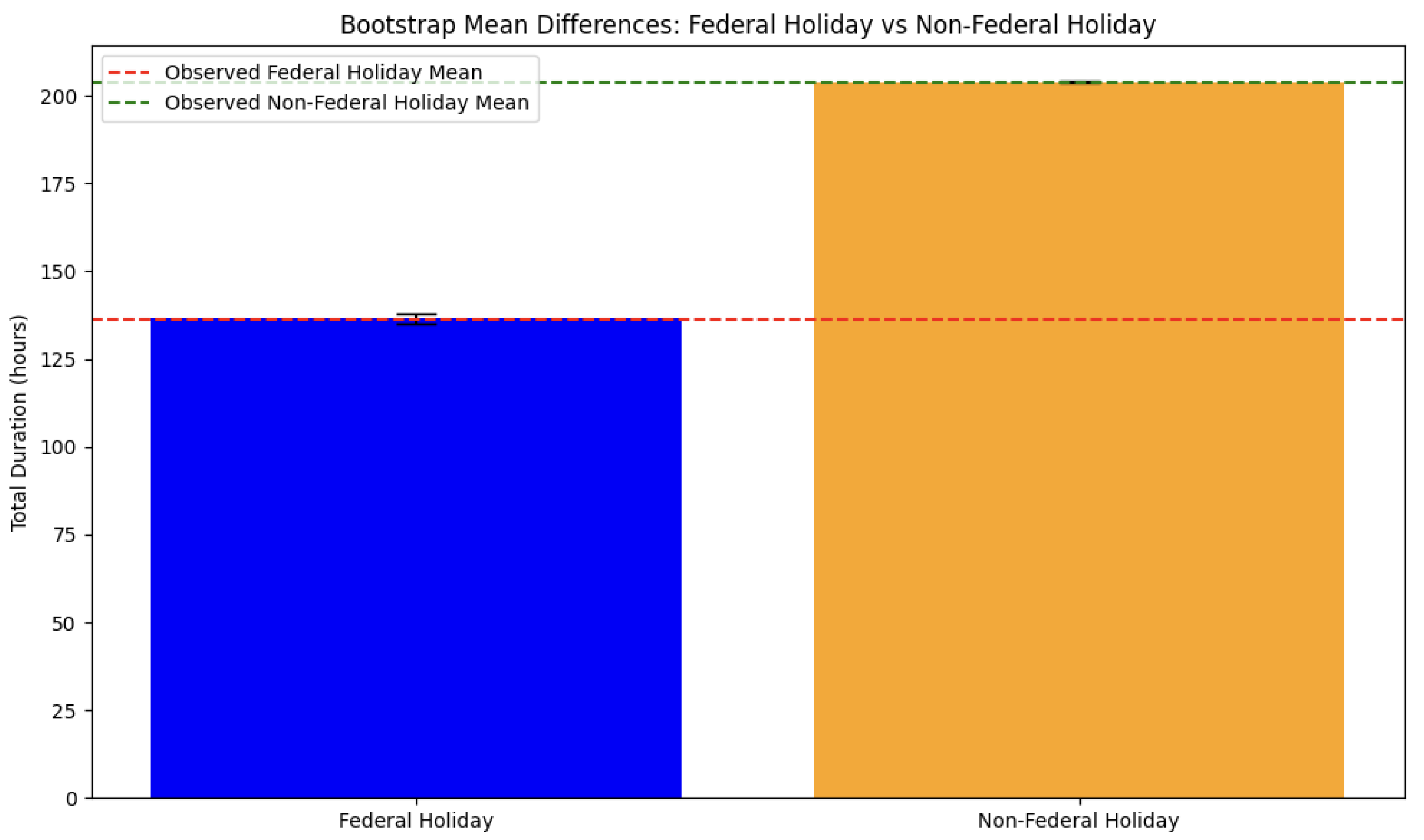

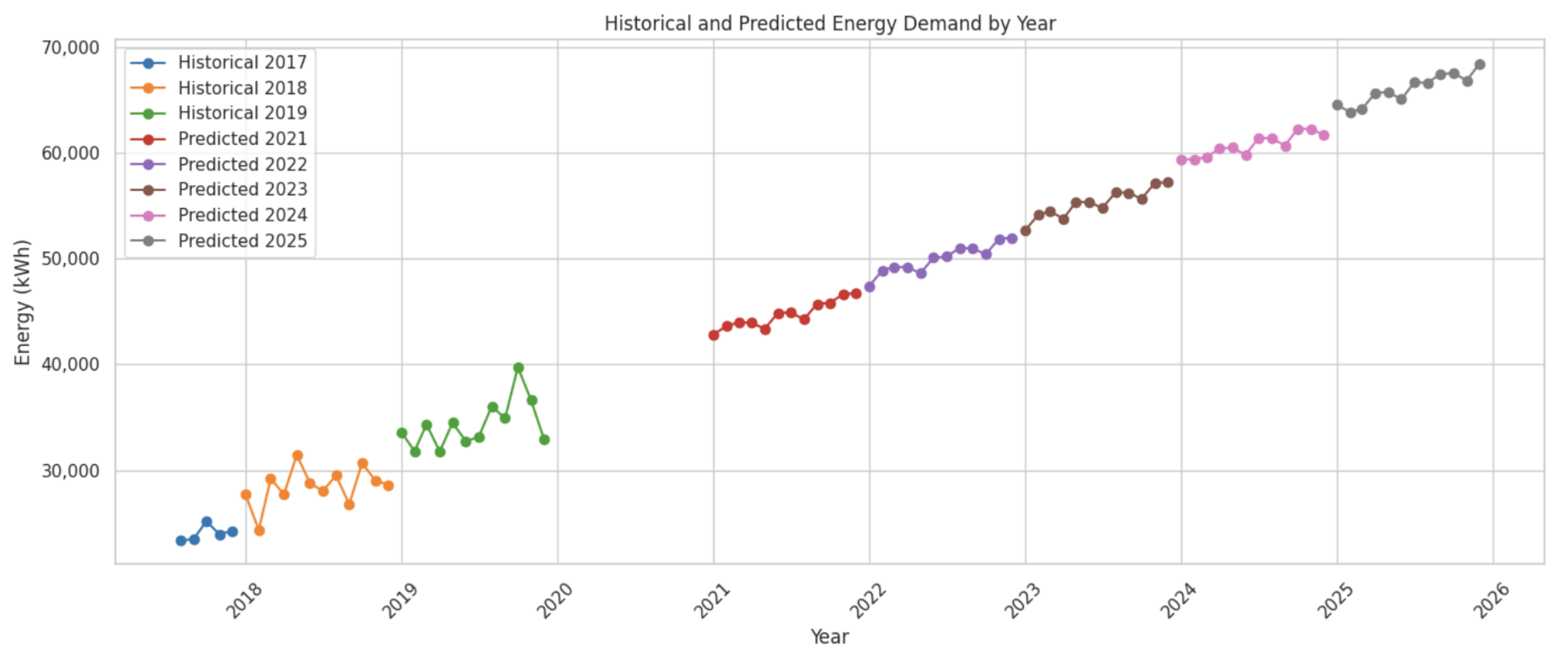

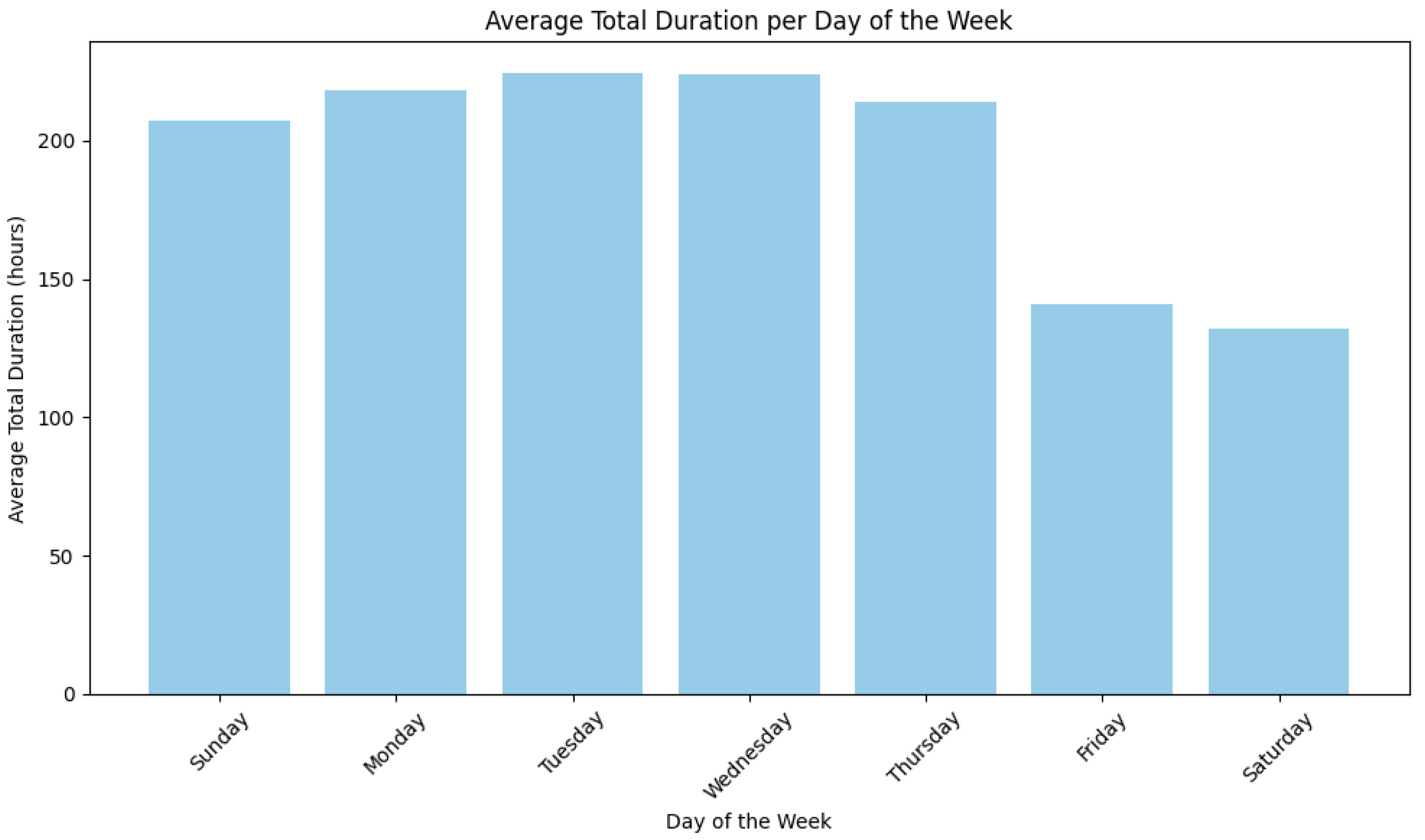
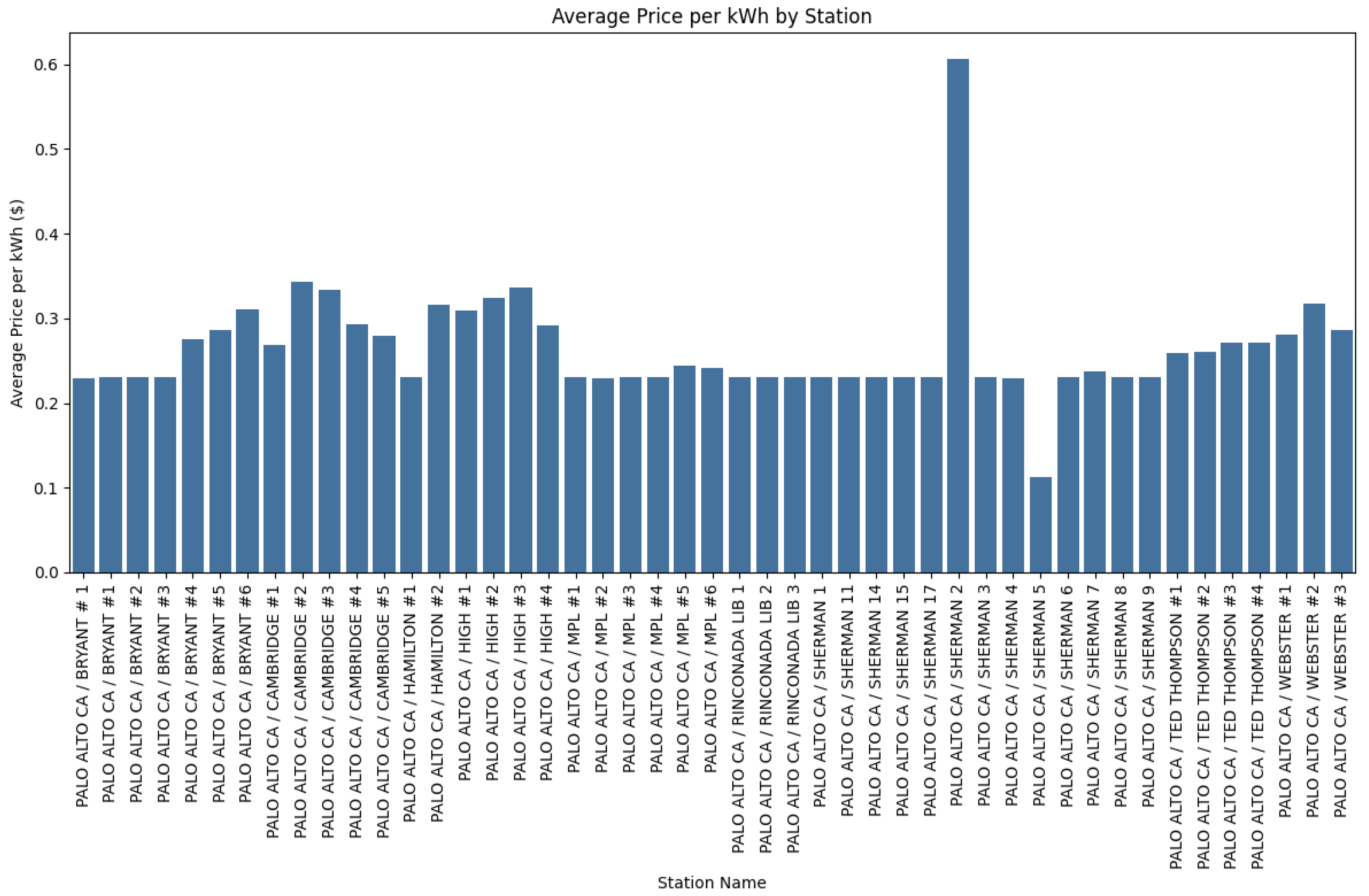
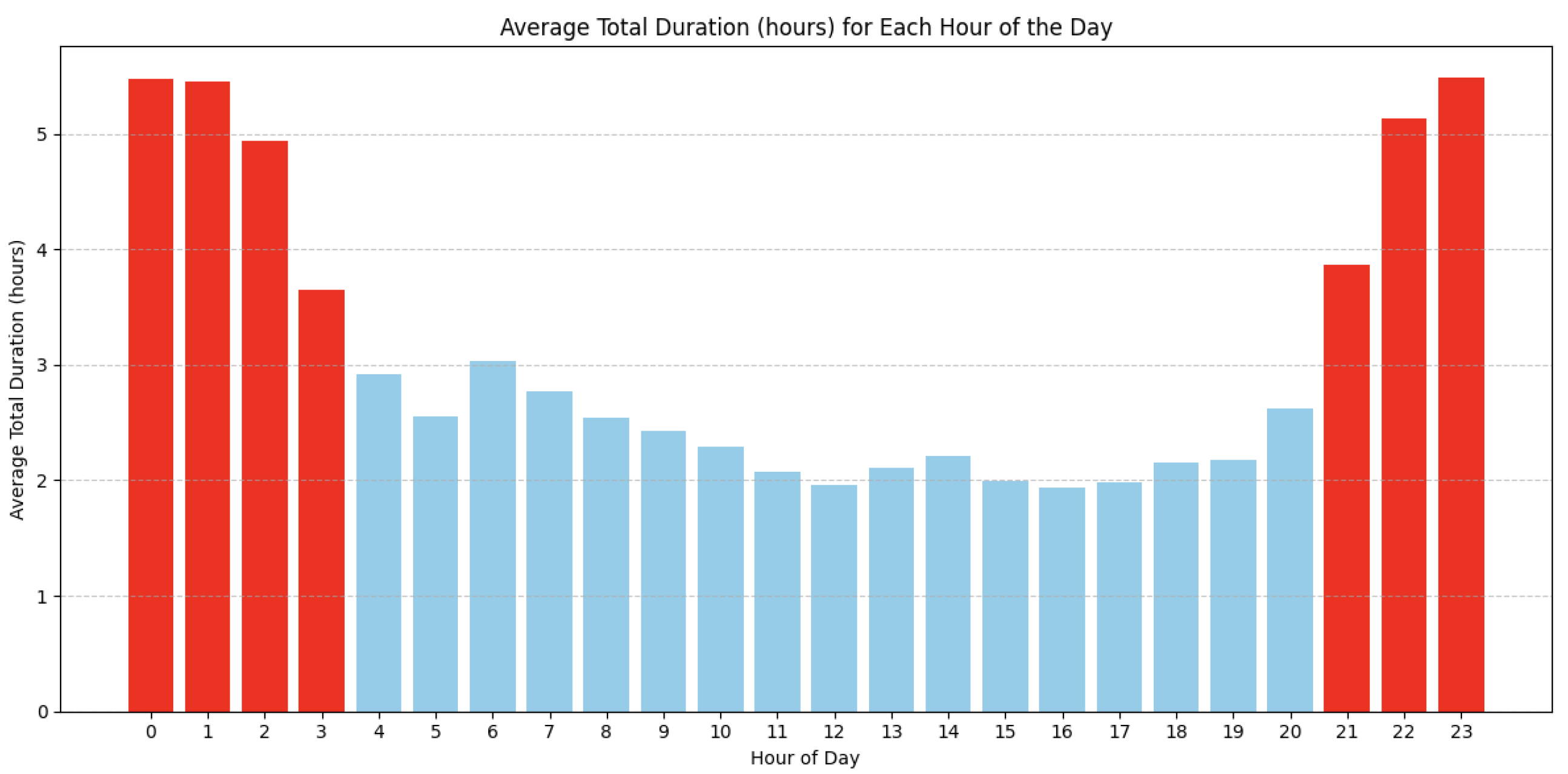
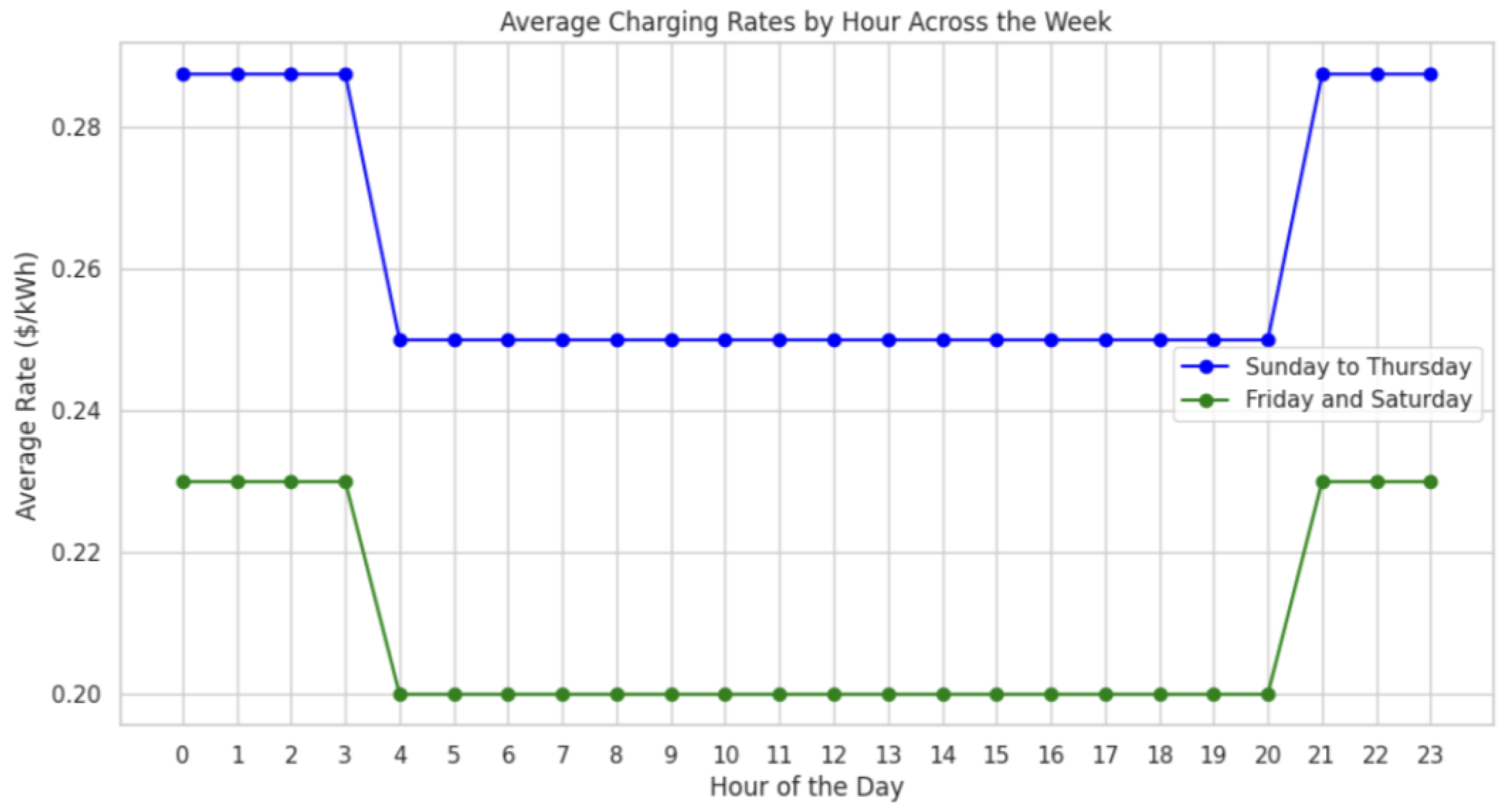
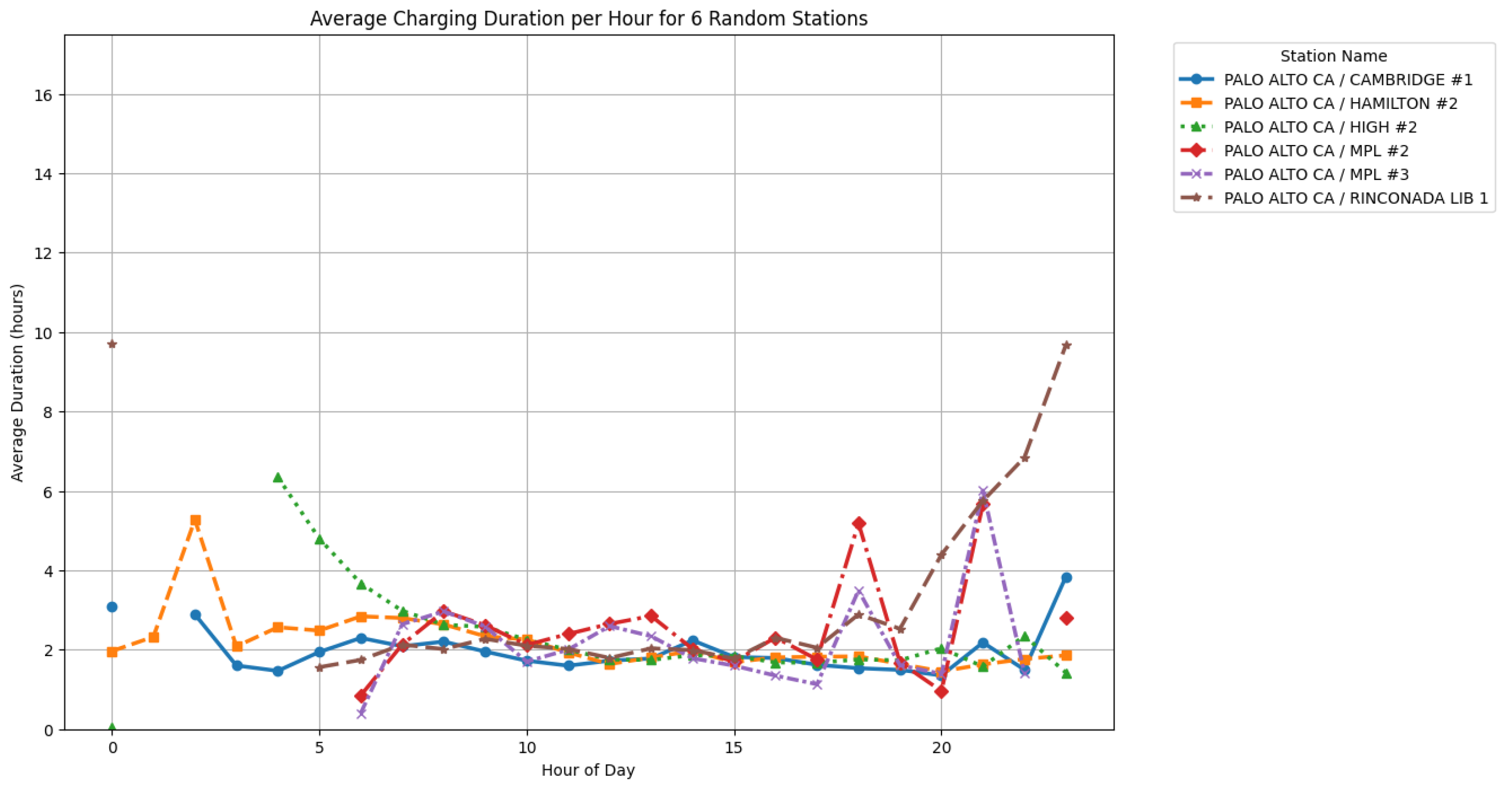
| Feature | Model | Role |
|---|---|---|
| Charging Time (seconds) | Green House Gases and Gasoline Savings Model | Duration of the charging session, affecting energy consumption. |
| Total Duration (seconds) | Green House Gases and Gasoline Savings Model | Overall event duration, impacting energy use and GHG savings. |
| Weekday or Weekend | Green House Gases and Gasoline Savings Model Dynamic Pricing Model Demand Forecasting Model | Indicates if the event occurred on a weekday or weekend, influencing charging patterns. |
| Holiday | Green House Gases and Gasoline Savings Model Dynamic Pricing Model Demand Forecasting Model | Indicates if the event occurred on a federal holiday, affecting charging behaviour. |
| Energy (kWh) | Green House Gases and Gasoline Savings Model Dynamic Pricing Model Demand Forecasting Model | Amount of energy consumed, directly influencing GHG savings, dynamic pricing, and needed infrastructure. |
| Port Type | Green House Gases and Gasoline Savings Model | Type of charging port used, which might affect efficiency and energy consumption. |
| Plug Type | Green House Gases and Gasoline Savings Model | Type of plug used, potentially influencing charging efficiency. |
| Year | Green House Gases and Gasoline Savings Model Dynamic Pricing Model Demand Forecasting Model | Year of the event, capturing trends and technological improvements. |
| Month | Green House Gases and Gasoline Savings Model | Month of the event, accounting for seasonal variations in energy use. |
| Day of Week | Green House Gases and Gasoline Savings Model Dynamic Pricing Model Demand Forecasting Model | Day of the week, which might influence charging patterns. |
| Gasoline Savings (gallons) | Green House Gases and Gasoline Savings Model | Amount of gasoline saved. |
| GHG Savings (kg) | Green House Gases and Gasoline Savings Model | Amount of green house gases saved. |
| Price Per kWh | Dynamic Pricing Model Demand Forecasting Model | The cost charged for every kilowatt-hour of electricity consumed. |
| YearMonth | Dynamic Pricing Model Demand Forecasting Model | Captures monthly patterns across years. |
| Type | Year | Energy (kWh) | GHG Savings (kg) | Gasoline Savings (Gallons) |
|---|---|---|---|---|
| Historical | 2017 | 120,236.561 | 50,499.356 | 15,029.570 |
| Historical | 2018 | 341,885.561 | 143,591.936 | 42,735.695 |
| Historical | 2019 | 412,152.592 | 173,104.089 | 51,519.074 |
| Predicted | 2021 | 536,640.843 | 225,389.154 | 67,080.105 |
| Predicted | 2022 | 599,780.185 | 251,907.678 | 74,972.523 |
| Predicted | 2023 | 662,919.526 | 278,426.201 | 82,864.941 |
| Predicted | 2024 | 728,712.560 | 306,059.275 | 91,089.070 |
| Predicted | 2025 | 792,446.619 | 332,827.580 | 99,055.827 |
| Needs | Might Need | Do Not Need |
|---|---|---|
| PALO ALTO CA/CAMBRIDGE | PALO ALTO CA/HAMILTON | PALO ALTO CA/MPL |
| PALO ALTO CA/HIGH | PALO ALTO CA/BRYANT | |
| PALO ALTO CA/TED THOMPSON | PALO ALTO CA/WEBSTER | PALO ALTO CA/RINCONDA LIB |
Disclaimer/Publisher’s Note: The statements, opinions and data contained in all publications are solely those of the individual author(s) and contributor(s) and not of MDPI and/or the editor(s). MDPI and/or the editor(s) disclaim responsibility for any injury to people or property resulting from any ideas, methods, instructions or products referred to in the content. |
© 2025 by the authors. Published by MDPI on behalf of the World Electric Vehicle Association. Licensee MDPI, Basel, Switzerland. This article is an open access article distributed under the terms and conditions of the Creative Commons Attribution (CC BY) license (https://creativecommons.org/licenses/by/4.0/).
Share and Cite
Jabr, O.; Ayaz, F.; Nekovee, M.; Saeed, N. Forecasting Infrastructure Needs, Environmental Impacts, and Dynamic Pricing for Electric Vehicle Charging. World Electr. Veh. J. 2025, 16, 410. https://doi.org/10.3390/wevj16080410
Jabr O, Ayaz F, Nekovee M, Saeed N. Forecasting Infrastructure Needs, Environmental Impacts, and Dynamic Pricing for Electric Vehicle Charging. World Electric Vehicle Journal. 2025; 16(8):410. https://doi.org/10.3390/wevj16080410
Chicago/Turabian StyleJabr, Osama, Ferheen Ayaz, Maziar Nekovee, and Nagham Saeed. 2025. "Forecasting Infrastructure Needs, Environmental Impacts, and Dynamic Pricing for Electric Vehicle Charging" World Electric Vehicle Journal 16, no. 8: 410. https://doi.org/10.3390/wevj16080410
APA StyleJabr, O., Ayaz, F., Nekovee, M., & Saeed, N. (2025). Forecasting Infrastructure Needs, Environmental Impacts, and Dynamic Pricing for Electric Vehicle Charging. World Electric Vehicle Journal, 16(8), 410. https://doi.org/10.3390/wevj16080410








